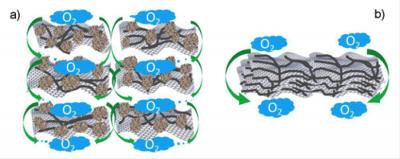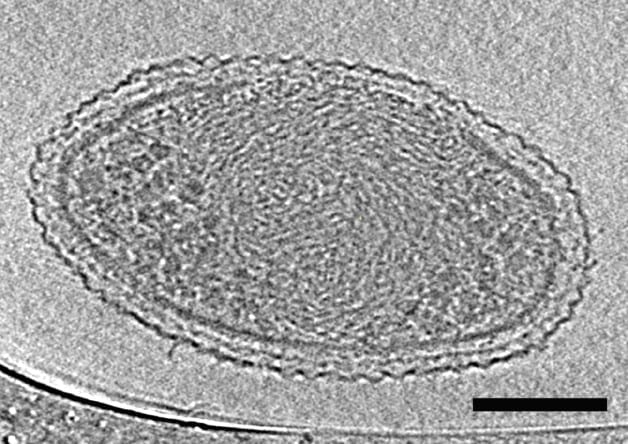
Graduate student James Stevenson, astronomer Jonathan Lunine and chemical engineer Paulette Clancy, with a Cassini image of Titan in the foreground of Saturn, and an azotosome, the theorized cell membrane on Titan.
Liquid water is a requirement for life on Earth. But in other, much colder worlds, life might exist beyond the bounds of water-based chemistry.
Taking a simultaneously imaginative and rigidly scientific view, Cornell chemical engineers and astronomers offer a template for life that could thrive in a harsh, cold world – specifically Titan, the giant moon of Saturn. A planetary body awash with seas not of water, but of liquid methane, Titan could harbor methane-based, oxygen-free cells that metabolize, reproduce and do everything life on Earth does.
Their theorized cell membrane, composed of small organic nitrogen compounds and capable of functioning in liquid methane temperatures of 292 degrees below zero, is published in Science Advances, Feb. 27. The work is led by chemical molecular dynamics expert Paulette Clancy, the Samuel W. and Diane M. Bodman Professor of Chemical and Biomolecular Engineering, with first author James Stevenson, a graduate student in chemical engineering. The paper’s co-author is Jonathan Lunine, the David C. Duncan Professor in the Physical Sciences in the College of Arts and Sciences’ Department of Astronomy.
Lunine is an expert on Saturn’s moons and an interdisciplinary scientist on the Cassini-Huygens mission that discovered methane-ethane seas on Titan. Intrigued by the possibilities of methane-based life on Titan, and armed with a grant from the Templeton Foundation to study non-aqueous life, Lunine sought assistance about a year ago from Cornell faculty with expertise in chemical modeling. Clancy, who had never met Lunine, offered to help.
“We’re not biologists, and we’re not astronomers, but we had the right tools,” Clancy said. “Perhaps it helped, because we didn’t come in with any preconceptions about what should be in a membrane and what shouldn’t. We just worked with the compounds that we knew were there and asked, ‘If this was your palette, what can you make out of that?’”
On Earth, life is based on the phospholipid bilayer membrane, the strong, permeable, water-based vesicle that houses the organic matter of every cell. A vesicle made from such a membrane is called a liposome. Thus, many astronomers seek extraterrestrial life in what’s called the circumstellar habitable zone, the narrow band around the sun in which liquid water can exist. But what if cells weren’t based on water, but on methane, which has a much lower freezing point?
Read more: Life ‘not as we know it’ possible on Saturn’s moon Titan
The Latest on: Methane-based life
[google_news title=”” keyword=”Methane-based life” num_posts=”10″ blurb_length=”0″ show_thumb=”left”]
via Google News
The Latest on: Methane-based life
- EPA Finalizes Methane Rule Associated with the Inflation Reduction Act Reporting Requirementson May 9, 2024 at 5:18 am
The Environmental Protection Agency (EPA) tightened greenhouse gas reporting requirements, adding more options for methane emissions monitoring and analysis ...
- To Clean Up Rice’s Methane, Startup Creates New Business Modelon May 8, 2024 at 3:00 am
Rice farming is a surprisingly large source of planet-warming methane. Yet while a solution to tackle emissions has existed for decades, farmers haven’t embraced it. Now, a startup has found a way to ...
- Streamlined life-cycle assessments of natural gas systems can inform near-term energy transitionon May 7, 2024 at 11:20 am
The natural gas industry is one of the largest greenhouse gas (GHG) emitters in the United States, and significant amounts of natural gas are used for electricity, heating, and industrial and chemical ...
- What can early Earth teach us about the search for life?on May 7, 2024 at 10:12 am
Earth is the only life-supporting planet we know of, so it's tempting to use it as a standard in the search for life elsewhere. But the modern Earth can't serve as a basis for evaluating exoplanets ...
- Alta. oil and gas company fined for violating methane ruleson May 7, 2024 at 9:09 am
CALGARY - The Alberta Energy Regulator has fined a Calgary-based junior oil and gas producer for failing to meet its fugitive emission and methane reporting requirements. *No charge for 4 weeks then ...
- The EPA Announces Final Rule to Cut Methane Emissions, Strengthen and Update Greenhouse Gas Emissions Reporting for the Oil and Gas Sectoron May 6, 2024 at 8:00 pm
The EPA has issued a final rule to strengthen, expand, and update methane emissions reporting requirements for petroleum and natural gas systems under ...
- Zefiro Methane Corp. Commences Trading on the Frankfurt Stock Exchangeon May 6, 2024 at 8:39 am
The FSE is the largest out of the seven stock exchanges in Germany. More information about Zefiro’s listing on the FSE can be obtained through the following link: ...
- No, the James Webb Space Telescope probably didn't detect signs of alien life — but it soon couldon May 3, 2024 at 3:00 am
The James Webb Space Telescope's possible detection of biological chemicals on the exoplanet K2-18b may just have been methane gas, a new study cautions. Planned follow-up observations could solve the ...
- Webb telescope probably didn't find life on an exoplanet—yeton May 2, 2024 at 8:01 am
Recent reports of NASA's James Webb Space Telescope finding signs of life on a distant planet understandably sparked excitement. A new study challenges this finding, but also outlines how the ...
- Australia's Major Emitters May Spew Twice More Methane Than Reported: Studyon April 29, 2024 at 7:50 am
Major polluters in Australia may be spewing more than double the methane estimated in its national inventory data, according to a report from the Melbourne-based nonprofit The Superpower Institute ...
via Bing News










